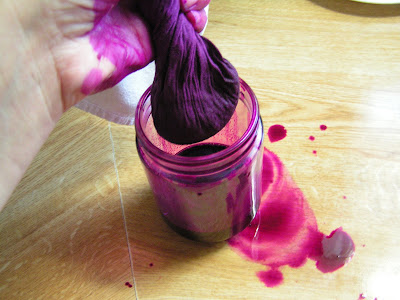Several days ago while out for my early morning walk
I encountered Neighbor and Mrs. M
(who were also out exercising.)
Neighbor M has a small home apple orchard
with which he kindly blesses the neighborhood
and his ever-widening circle of friends.
On this crisp and beautiful morning
he inquired if our family would be interested
in picking some apples to put up for our winter larder.
Now who could turn down an offer like that?!
I assured him we would love to come a bit later in the day
and pick some apples,
and then I boldly asked if he had his antique cider press ready for action yet,
as I wanted the Treasure to experience that process
one more time before we leave the neighborhood for good.
He assured me that it was up and ready
and to come on over and we would make some apple cider.
Mid morning we headed that way.
So here's how we made apple cider on that beautiful day in September.
First, you get the tools out,
then you shake the trees
and pick up the apples.
Note the tools used for gathering the apples.
They are actually marketed for gathering nuts,
but they work dandily for apples, too!
You just roll the wire cage over the fruit
and the apples pop themselves into the contraption.
Then you take the gathered goods to the collection container,
open the flexible wires and let them drop out.
Easy-Peasy.
And it saves a lot of backaches!
This is the tool that Neighbor M uses to shake the trees.
It is also used for pruning...but at present I can't tell you which hook is which,
as I'm not that familiar with the tool.
It is very handy, definately a must have for orcharding.
After gathering the apples
(we had about 5 crates)
you plunk them in big containers of water
and splash them up and down to clean them well.
Next you sit in a friendly group around the buckets of wet apples
with knives and while you visit you cut out the worm holes and bad spots,
putting the yucky stuff in a separate bucket,
and the good apples and parts in another big container of water
and they are splashed and rinsed well again,
then placed in a crate by the apple cider press.
Many hands make light work!
Here the apples are,
spiffy clean and pared and waiting for the big squeeze.
When we first moved to the 'hood around 20 years ago,
Neighbor M had a hand crank on this press
and we all took turns making it go 'round.
A year or two ago, the internal mechanisms of the press were getting loose
and so Neighbor M had some repairs made to it
and now it is tight and difficult to turn,
so he attached a motor.
Efficient, but I miss the nostalgia of the hand crank.
The apples are placed in the hopper on top,
and there is a chopping mechanism
then two geared wheels that grind and crush the flesh.
The pulp drops into the slatted barrel beneath.
Here the hopper has been removed
and you can see the geared wheels that
grind/crush the fruit as they turn inward toward each other.
When the slatted barrel is crammed full of juicy apple bits,
it is slid forward on the stainless tray
until it is beneath the pressing mechanism.
A wooden lid is placed on top
then a wheel is turned by hand to lower the iron screw
so it forces the wooden lid down on top of the apple pulp.
The mechanical pressing force
causes the juice to run out of the apple pulp,
through the slats of the barrel,
down the stainless tray
and into the waiting bowl below.
The cotton fabric lining the bowl is used as a strainer,
as invariably there is some debris that flows in with the juice.
There are many insects that come to investigate the process,
and some of them are so greedy
they drown themselves in the golden goodness!
Since most of them come with stingers on one end,
having a cloth for a filter is a good thing.
Finally, the juice is carefully poured into clean containers.
The black wooden contraption at the top of the photo
is one of two jigs that Neighbor M created
to help hold the variety of plastic bottles used to store the juice
so they don't get knocked over while being filled.
Here's the apple pulp that is left after pressing.
It makes great compost, or,
great food for wildlife or livestock.
Neighbor M has a friend that likes to feed it to his cows.
They think it is candy!
And there you have it,
freshly made old-fashioned apple cider.
This pressing yielded 4-5 gallons of cider out of about 5 crates of apples.
We are bountifully blessed...
...we had the fun of making it...
...the joy of fellowship and a sense of community,
and we will enjoy its goodness for weeks to come.
And we will cherish the memories for many years.
A delicious way to satisfy our thirst!
Many thanks to Neighbor and Mrs. M.
XOXOXOX!!!



















































